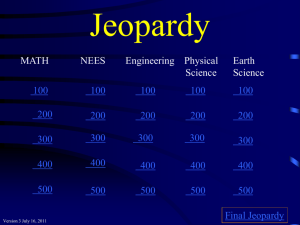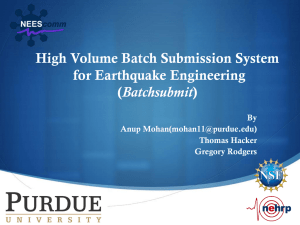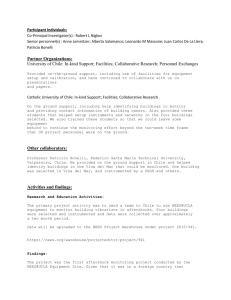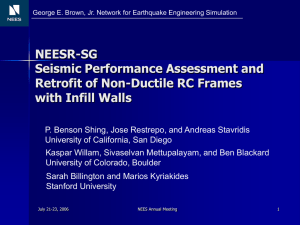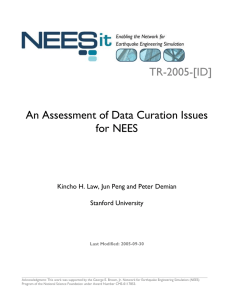Teleoperation and Teleparticipation of Instructional Shake Tables
advertisement
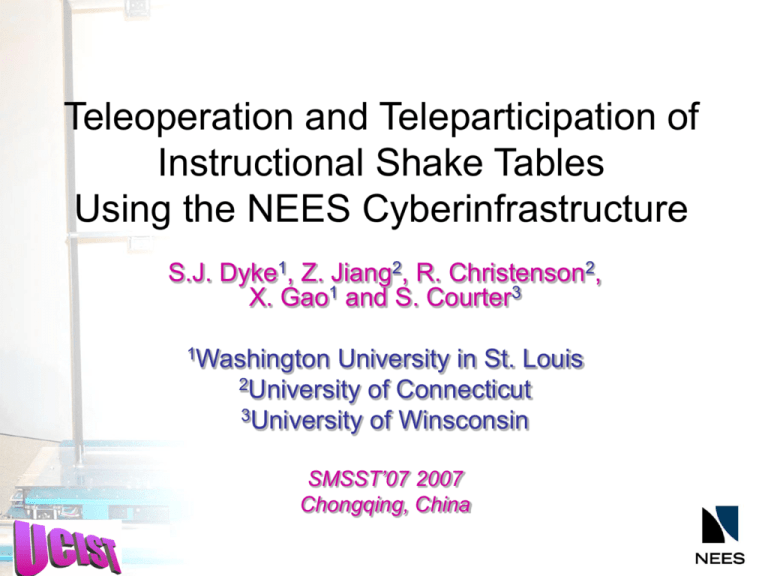
Teleoperation and Teleparticipation of Instructional Shake Tables Using the NEES Cyberinfrastructure S.J. Dyke1, Z. Jiang2, R. Christenson2, X. Gao1 and S. Courter3 1Washington University in St. Louis 2University of Connecticut 3University of Winsconsin SMSST’07 2007 Chongqing, China Background: UCIST University of Alaska – Fairbanks University of Hawaii Oregon State Univ. Penn State Univ. or Nevada - Reno UC Davis Univ. of Utah Stanford San Jose State Univ. CalPoly Washington Univ. Univ. of Nevada – Las Vegas Notre Dame UIUC Virginia Tech Southern Illinois Univ. - Edwardsville UCLA UC-Irvine UC San Diego Florida A& M Currently over 100 Universities internationally are members ! Remote Users (Faculty, Students, Practitioners) Instrumented Structures and Sites NEES Resources Simulation Tools Repository Laboratory Equipment Field Equipment Curated Data Repository Leading Edge Computation Global Connections Remote Users: Laboratory Equipment (K-12 Faculty and Students) Introduction Existing state-of-the-art cyberinfrastructure tools developed by NEESit, the technical support and development component of NEES, have been developed recently for teleparticipation and teleoperation. We plan to take advantage of these capabilities to educate the next generation of civil engineers! Outline • Objectives of the Collaboratory • Lab Station Components – Equipment – NEES Implementation • Instructional Materials Available – Freshman Level Undergraduate Module – Evaluation Plan • Closing Objectives of the Collaboratory • To provide engineering students – an understanding of structural dynamics – experience with modern laboratory equipment and instrumentation – exposure to NEES and the latest capabilities regarding remote testing teleparticipation tools – provide a mechanism for training students to perform experiments – opportunities for K-12 outreach Objectives of the Collaboratory • 2 Lead Institutions – develop 2 initial exercises – evaluation & adapt • 5 Deployment Sites – implement 2 exercise – develop new exercises • Available to users Lab Station: Overview Lab Station: Activities University of California, Berkeley Model Shake--Aftermath NEES: Teleparticipation Viewing and analysis of streaming data and video over the internet • Enable researchers to remotely participate experiments • Allow for classroom demonstrations and hands-on experimentation on physical structures NEES: Teleoperation Remotely controlling the UCIST shake table using the NEES cyberinfrastructure tools • Facilitate new testing methods such as distributed hybrid testing • To allow remote user (students) to control hands-on experimentation on physical structures NEES Implementation At the University of Connecticut NEES Implementation UCIST PC (NTCP for MATLAB Machine) UCIST Shake Table MATLAB / Simulink / WinCon Remote PC NTCP Client NTCP Server WebDaemon RDV RBNB Data Turbine PC Web Camera Introduction to Earthquake Engineering: Spring 2007 Freshman Engineering module developed at the University of Connecticut Instructional Materials • Students learn necessary mathematics to study the forced and free vibration of a single-degree-of-freedom structure • A 1-story seismically excited shear frame is used to apply their new knowledge Instructional Materials • Overview (Freshman Level 3 weeks) – Earthquake Engineering Introduction – SDOF Equations of Motion – Programming in Matlab – NEES Introduction – Teleparticipation & Teleoperation of Actual Experiment • Each student is required to submit weekly homeworks and a final lab report including a discussion of observations and results Instructional Materials • Evaluation & Feedback – On-line surveys conducted to obtain student input – Evaluation expert is part of the project • Comments – “[It] Was very hands on, and many people learn better by doing and seeing than just calculations” – “It was a very interesting experience. The fact that you could manipulate a structure in an-other building across campus from you room is amazing.” Acknowledgments • UCIST (1998-2002) – Support for UCIST from NSF Grant (DUE 9950340) – Mid-America Earthquake Center • • • • • NSF DUE 0618605 (CCLI Program) Washington University in St. Louis University of Connecticut 5 Deployment Sites Quanser Consulting For more information see: http://ucist.cive.wustl.edu/
